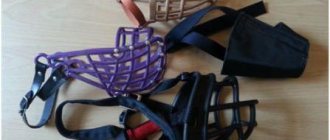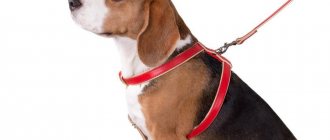What is a clicker
A dog training clicker looks like a small box, no larger than a matchbox. Inside there is a small metal plate that makes a specific sound when you press it with your finger through a button on the body of the device.
Note! The device does not use infrared radiation, ultrasound or current to train four-legged pets.
For these purposes, a simple click is used, which helps the animal better assimilate the owner’s commands.
Types of clickers
There are two types of clicker for dog training: with a plate and a push-button one.
- Clicker with plate. This type of device has a simple mechanism and is easy to use. To activate it, you need to press the metal plate with your thumb, which is not always convenient, especially during the winter cold. The most common devices of this type are devices from Trixie. Their cost is about 120 rubles. These dog clickers are preferred for outdoor use as they produce a fairly loud sound.
- Clerk with a button. This type of training device is very convenient because it is activated using a button that is easy to press. Push-button clickers have an additional accessory - a soft spring ring that is attached to the device. With its help, you can hang the clicker on your hand, and also quickly find it in your bag. Trixie produces this type of clicker in the form of a dog's paw. Its cost does not exceed 250 rubles. This model also has a drawback - quiet sound. There are more expensive devices, for example, StarMark, which costs about 260 rubles. The company produces a clicker of a characteristic type: oval in shape, blue in color and with an orange button located in the center. However, the basic configuration of this model does not include a ring-spring, but it can be purchased separately. The Clik-Stik dog clicker has an oblong shape and is equipped with a pointer. The price of this model is 770 rubles.
Basic Clicker Functions
The main function of the clicker is to encourage the animal to act correctly. The device can be used for training both large animals and small puppies. Dogs are prepared in a similar way for participation in circus acts, competitions, exhibitions, and also for hunting.
This method of raising animals is currently considered the most effective and safe, since the training process does not require the use of punishment, which can traumatize the dog’s psyche.
Basic rules for using a clicker
Be sure to read the rules to understand how to use a dog clicker:
- Do not start teaching commands using a clicker if the dog has not yet developed a conditioned reflex.
- The click must be used to confirm the dog's correct actions during the desired behavior to avoid the formation of incorrect connections, and to non-violently communicate to the dog what it is about.
- A dog clicker should not be used to attract or recall the dog's attention.
- Desired behavior details must be reinforced with a “click.” After this, the dog receives its reward. Thus, the dog’s own behavioral suggestions can also bring success to the dog.
- If you want to achieve outstanding results, increase the quantity and improve the quality of treats . This is considered a "jackpot" for the dog.
- The dog must periodically have the opportunity to receive a jackpot. This will further spur her on. The jackpot is awarded only when the dog has made a significant breakthrough in the exercise.
- Often, after a click, the dog runs up to get a treat . This is completely normal - the “click” ends the exercise and should be confirmed.
- Unwanted behavior should not attract your attention . The training is free of penalties. No "click" spells failure for sensitive dogs doing intensive clicker training. Therefore, it is always better to divide the exercise into several small parts so that the dog more often has confirmation in the form of a clicker signal.
- Dog clicker training is not command-oriented. Its goal is to form and consolidate the desired type of behavior. Only when the dog reliably displays the desired behavior are individual commands or signals introduced. This is a big advantage compared to conventional training, since in this case the dog always associates the signal with the optimal achievement.
- Once a specific behavior is brought under the command's control in such an exercise, the clicker is no longer needed .
Source
How does a dog clicker work?
When the owner understands what it is - a clicker for dogs, you can start training your pets. The principle of operation of the device is based on the fact that in humans the mechanical reaction is better developed than the verbal one and is ahead of it. The mechanism of operation of the product is simple: you just need to press a button at the moment your pet performs the desired action.
Note! Some breeders find it easier to mark the behavior of the animal in accordance with the desires with words, but after a few training days the hand becomes accustomed to using the clicker.
The dog can hear the verbal marker in everyday life, which is why it is devalued. The pet does not have a strong positive reaction associated with correct actions on its part. Therefore, to speed up the learning process, it is recommended to use a clicker.
Dog training using clicker training
Clicker for dogs, how to use during training
To achieve good results in training, you need to know how to use a dog clicker correctly. There are some rules for its use.
- Training should be frequent, but not very long. It is better to exercise with your dog daily for 20 minutes than 1-2 times a week for an hour. Short intervals between training allow the animal to better assimilate and remember commands.
- It is better to start training with simple commands, for example, “Sit” or “Give me a paw”, gradually increasing the level of complexity.
- The command must always be accompanied by a voice. Communicate clearly and loudly about everything you want from your dog.
- The clicker itself is not a method of reward, so before training you should stock up on a handful of some kind of treat. You can also show your dog that he is doing everything right by stroking or scratching.
- It is optimal to train an animal using “sweets” when the dog is hungry, otherwise he may not respond to food and the training will not be effective.
- It is better to conduct initial training in a quiet place so that the animal is not distracted by extraneous sounds and learns to understand the principle of operation of a clicker for dogs. This way she develops a conditioned reflex, and subsequent training will be easier.
- One reward should correspond to one click of the device. It is better to elicit additional approval through food or affection.
- Proper training eliminates scolding the dog for its incorrect behavior. It is better to focus on her positive actions, even small ones, than to shout at her for her misstep. Clicking the device after the dog does something good will show that you are pleased with its behavior and, conversely, the absence of a click, for example, when it barks loudly, will indicate your disapproval.
On the subject: Running training plan for weight loss
How the owner should use the device. Schematically, the entire training using a clicker for dog training looks like this:
- a command is given by voice;
- correct execution by the dog;
- clicker click;
- encouragement
Only this sequence should be observed during each training session.
Benefits of a clicker for dog training
Clicker training for dogs has a number of advantages when used during training. However, there can be only one drawback - it may be ineffective in some cases related to the pet’s poor hearing.
Translation into dog language
Often problems with training arise not because of the pet’s reluctance to learn or its bad mood, but simply because of the owner’s lack of understanding. Because of this, the animal owner may become angry, which amounts to punishing the dog. The dog begins to become stressed, which is why he avoids activities in every possible way.
A dog clicker helps get rid of the problem. The click must be made at the moment when the animal has performed the correct action that was expected of it. Such a translator into dog language will help avoid the confusion that can be read in the dog’s eyes. The click should also be accompanied by a reward.
Increased learning ability
If you use a dog clicker, their learning speed increases. For the animal, the click of the device is different from other sounds that the pet is accustomed to hearing. The dog does not understand what is required of it, since animals do not perceive smooth conversation with slurred intonation.
Attention! Clicking the clicker will allow the dog to clearly understand the owner. In this case, the animal knows exactly why it was praised.
Improved memorability
A person remembers better what he himself has achieved, and not what was presented to him on a silver platter and carefully chewed. The situation is the same with pets.
Without obvious influence from the owner on the dog, the animal develops initiative and independent thinking. The skills acquired as a result of work are better absorbed.
The dog looks at the clicker
When to press the clicker button when training dogs?
Let's look at an example. We want the dog to touch his nose with his paw. Now we have already glued a piece of electrical tape to her muzzle or wrapped a hair elastic around her muzzle. The dog senses a new object and, trying to remove it, lifts its front paw and touches its nose. At this moment we say: “Yesss.” The dog, having touched his nose for a split second, begins to lower his paw, listens to our “Yesss” and happily eats the offered piece of reward. Why did we reward the dog? Because she touched the tip of her nose? For tearing his paw off? For holding his paw down?
The same example with the clicker: the clicker sounds short and dry. And here everything depends on the owner’s correct timing: if he managed to click at the moment the paw touches the nose, everything is fine, we told the dog at what point in the action he receives the treat. If we hesitated a little, and the dog heard a click at the moment when the paw began to move down... well, you yourself understood that here we accidentally encouraged the moment of lowering the paw from the nose to the ground. And our pet understands: “Yeah, the paw needs to be a centimeter from the nose!” And then we bang our heads against the wall: why doesn’t the dog understand us?
This is why when practicing difficult tricks that require very high quality timed reinforcement timing, I strongly recommend filming training sessions so that we can then analyze them and whether we are responding correctly on time.
If we compare the two situations described above, we can conclude that a clicker is a clearer and more precise marker of correct behavior, which means it is worth using it in the training process. But at the same time, for proper use it requires a clear and timely reaction from the owner. At the same time, even if you realize that you clicked at the wrong time, do not skimp on encouragement: for one mistake that you “bought” by giving out a piece, you will not bring the skill to automaticity, but you definitely should not devalue the sound of the clicker. The golden rule of clicker training is: click = yum. That is, if they clicked, extend the encouragement.
Basic rules for training with a device
Few pet owners know how to use a clicker to train their dogs. First of all, the pet must understand what the sound signal means. You need to follow some rules so that your four-legged friend responds to the click of the device.
- You need to take a dog treat in your hand. You need to attract the animal's attention with a click and give it a reward. There is no need to immediately ask to execute certain commands. The sound should be associated with a reward.
- The first time is to click at the moment when the dog looks at the owner. Subsequently, you can make sounds with a clicker at any time, but the pet must be interested in receiving a treat. It is necessary to develop a reflex in him.
- After a few days, it is worth checking whether the clicker works on the dog. If the animal's ears rise and it turns its head in the direction of the sound, then the signal is working.
- It is necessary to use a clicker with a treat first of all on commands familiar to the animal. Even an untrained dog performs some actions at the owner's request. One of these is the call, as well as the reaction to the nickname.
Important! The test should not be performed too often as this may reinforce the animal's random actions.
"Place"
Another very useful behavior that can be taught to a cat is to go and stay in a certain place on command.
This command is one of the types of target training, only here the target is not a stick with a ball at the end, but a mat. And the cat’s task is not only to touch the ball with its nose, but to move its entire body to the indicated place. Such activities are easy and give the cat great pleasure. In practice, you can use the command when you want your cat to jump on your lap, on a shelf, in your bag, or sit next to you on the sofa - anywhere you specify. With a command you tell the cat: “Jump here and stay here” and the cat absolutely understands the meaning of your words and after class will respond to your proposal with joy. The "Place" command is useful for teaching your cat where it is good and proper to be, for example, on a chair rather than on the dining table; to be at home, and not rush out the door. This allows us to change unwanted behavior with the help of positive reinforcement, giving the cat information about what its behavior is correct and good. Positive reinforcement increases the likelihood of desired behavior in the future. Punishment does not lead to predictable results. So, the first thing we need is a rug. A mouse pad, a chair cushion, a small towel, or something that feels good to step on will be great for your cat. We will teach three behaviors:
Go to the mat - Leave the mat - Stay on the mat
Throw the rug on the floor and wait for the cat to step on it with one paw (if it doesn’t step at first, then at least sniff or look): click!
Click on one paw on the mat, then on two paws. Catch the behavior. If the cat sits on the mat, click and give her the jackpot (a handful of treats several times larger than usual)!
Now throw a piece of treat to the side to get the cat off the mat and say “That’s it!” While your cat is eating the treat, move the mat a little. Continue playing - you place the rug in different places, and the cat sits on it. First, move the mat a few centimeters, and then move on to another place. When the cat is in a hurry to sit on the mat, add the command “Place!” Now we have a happy cat sitting on the rug. Click and give her a treat because she sits and does not move from her place, first 2, then 5 and 10 seconds, and so on. Release by throwing a treat with the words “That’s it!” Remember to vary your activities and make them interesting.
Basic commands using a clicker
When the dog begins to respond to the sound of the training, you can begin training it. After each command executed, the pet should receive a signal that it did everything correctly. The clicker can be used for walks. To do this, it is not even necessary to execute a specific command. An animal can pass by a bait lying on the ground without paying attention to it; the owner at this moment should encourage the pet’s behavior with a click.
Treating the dog with a treat
Clicker training is easy and relaxed. However, the device must be used correctly. To do this, you should know certain rules that should not be violated:
- You can only click once before giving the reward to the animal. In just a few clicks, it's worth giving a few pieces of treats.
- The duration of the workout should not exceed 15 minutes.
- You should not press the treasured button if you have run out of treats, since its absence is a deception for your pet. He will become frustrated and subsequently stop obeying.
- You should encourage the animal with your voice only after the device clicks.
- You should not call your pet on the street using a clicker. The dog will believe that he is receiving a reward for being far away from the owner, so he will strive to increase the distance.
- Before training, you should not feed your pet so that the reward is desirable.
Note! The treat should be soft and small, even if the pet is quite large.
The main obedience commands are:
- "Lie!";
- "Place!";
- "Sit!";
- "To me!";
- "Near!".
The use of a clicker must be considered. You cannot use the device at random. You should not expect your pet to continue following the command after it receives a sound signal. He will understand that he did everything right, and therefore will begin to rejoice and ask for a treat.
You need to decide for yourself what exactly to demand from the animal. If you want your pet to simply follow a command, then you can click the button after he sits down. If it is necessary to train the animal to remain in this position, then you need to wait a few seconds, and only then make the coveted sound.
Clicker training: a fashion trend or an effective method?
Contents hide
Clicker training: a fashion trend or an effective method?
Today, more and more people are interested in training. Some people just need to teach their pet the basic commands “Come to me” and “Sit,” while others found entire schools with proprietary teaching methods. In this article we will look at one of the very common methods - clicker training.
A clicker is a small, usually plastic object with a button that, when pressed, makes a click. This device is the main thing in the training process. Its history goes back to the middle of the twentieth century. The clicker subsequently became widespread thanks to Karen Pryre's dolphin shows and her book Don't Growl at the Dog.
How to use a clicker? To begin with, you must make it clear to the dog that the click he makes is an indication that a reward is coming next. To do this, prepare about 5 small pieces of treats. After each click, immediately treat your pet with a treat. After 5 times, take a break and then repeat 2 more times. The dog must firmly understand that after clicking, a reward awaits it. Next time, try increasing the time between the click and the treat, but not by much.
The foundation has been laid. Next, you will only need to reinforce the desired action with this click. For example, if a dog gives you a paw, and this is exactly what you wanted to teach it to do, then just click at the moment the action is performed, and the pet will understand what is required of it. Important! You must click exactly at the moment the action is performed, without delay. If the dog has already performed the action and lowered its paw, then it will be too late to click, since you will thus reinforce another action.
The advantage of this method is that it does not use punishment and it is suitable for quite a lot of animals (in addition to dogs, owners of cats, horses and even wild animals actively use it). Any wrong action is simply ignored. Soon the pet begins to show its creativity, offering different tricks and elements of behavior. This way, your four-legged friend will become interested in learning, and he will begin to take the initiative.
Basic rules for working with a clicker:
If you want to praise your pet for making a big learning breakthrough, don't click multiple times. It is enough to treat him with a larger amount of treats than usual, or give him more delicious treats; The clicker only reinforces the dog's desired behavior. It should not be used to attract attention or play.
Many people think that when working with a clicker they will always have to carry it with them. This is wrong. After training the dog's command, it will obey your voice or gesture without additional reinforcement. In addition, with such training it is not necessary to reward the pet only with food. You can use play or affection instead.
It is worth noting, however, that despite its popularity and simplicity, clicker training may not be suitable for everyone. If you succeed, you will spend many wonderful minutes teaching your pet various tricks and observing the tricks he suggests that, in his opinion, you might like.
Photo source: https://fb.ru/misc/i/gallery/31722/976258.jpg
Review of popular models of clicker training for dogs
At the moment, veterinary stores have a wide variety of clicker training for members of the canine family. They differ not only in price, but also in functionality. The most popular are:
- Trixie. The company produces devices with a plate and a button. For models with a plate, a characteristic feature is the presence of a volume control button. The device with the button is loud enough, suitable for use while walking. To make it convenient to carry the device, it has a nylon cord or a bracelet with a spring.
- Deluxe. Clicker models of this brand allow you to clearly record the correct behavior in your pet’s mind. The device is made from environmentally friendly materials that are safe for pets. Products of ergonomic shape with a bracelet on a spring.
- Click-R. The device is ergonomically shaped with a comfortable strap that allows you to secure the device on your finger or wrist. The design can be chosen at your discretion.
Additional Information! The devices differ little in their functionality, since they are a simple device. The only differences can be seen in the strap and design. The pricing policy is approximately the same for all brands.
Clicker in hand
Is it possible to make a clicker with your own hands?
You can make the device yourself at home. This doesn't require any special talent. You just need to find a small object that will produce a characteristic click.
For these purposes, you can use a baby food cap, a piezo lighter element, or a ballpoint pen with a button. However, if the product breaks, you will subsequently have to look for it with the same sound.
Proper use of a dog training device will help you achieve the desired result faster. A special mutual understanding will arise between the animal and the owner; the dog will independently guess what they want from it.











